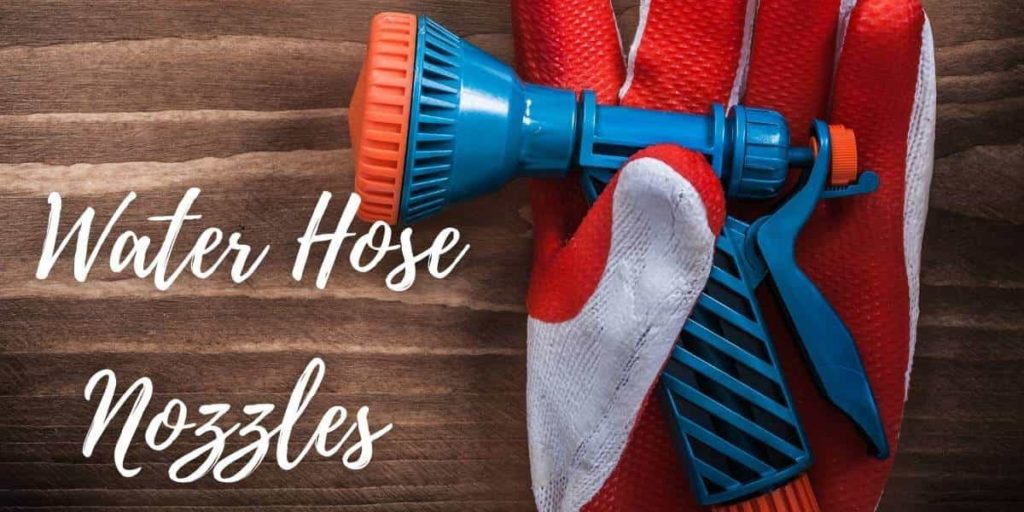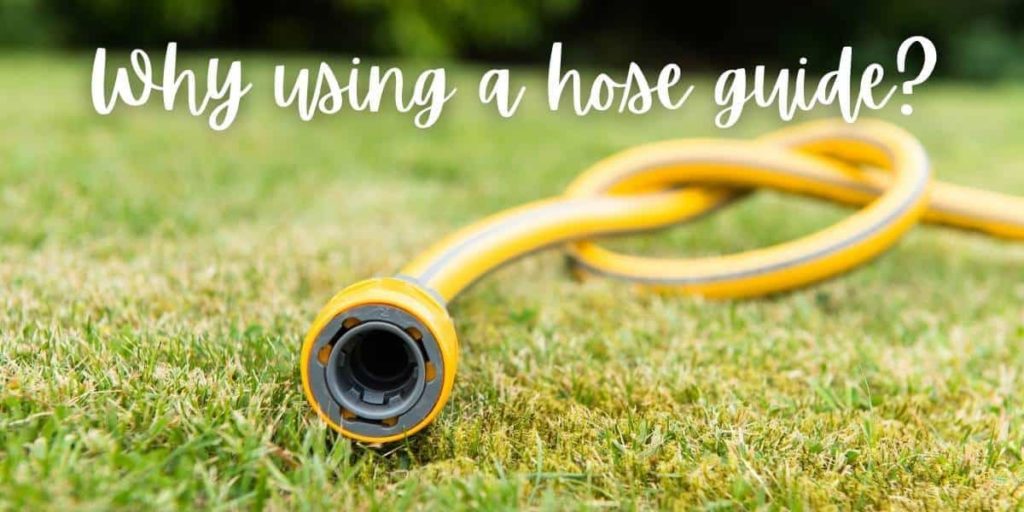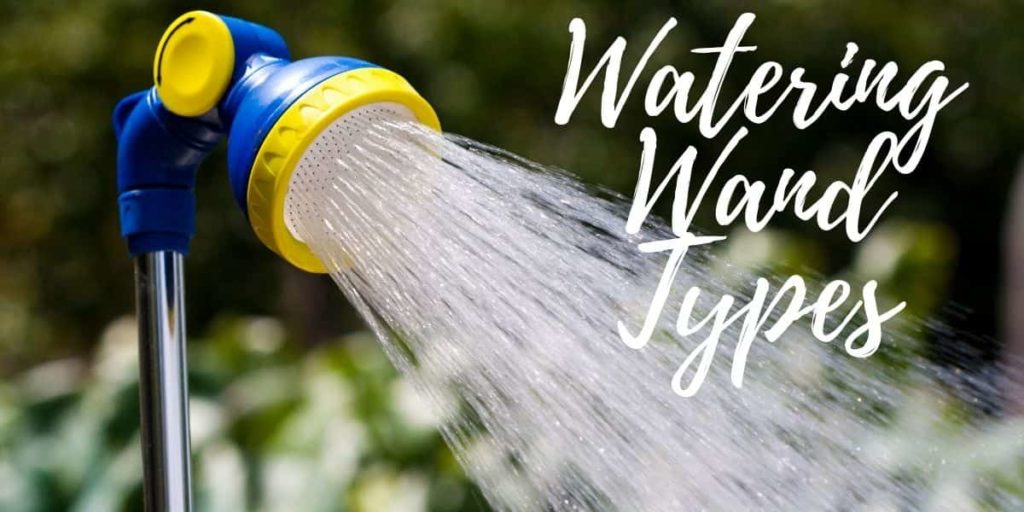What Is A Garden Hose Nozzle
Of course, you can use your gardening hose as it, without adding any other hose-end attachment to it. You can simply use your finger on the end of the hose to change the water flow pattern or direction. But why do that when water hose nozzle sprayers exist?
In this post, we will share important details about what hose nozzle sprayers are, how they work and how to use them. You will also find here a post section dedicated to the main hose nozzle watering patterns. Therefore, make sure to read the entire post!
So, let’s dig right in!
A water hose nozzle is a steady flow engineering device. We use it to increase the water velocity. The water nozzle has an inbuilt mechanism that controls the water direction, the water break up into droplets, and the dispersion pattern of the water that flows through it. A water nozzle is a simple device used to change the fluid flow into a specific spray pattern.
There are several different terms we use for naming water nozzles, for example, garden hose sprayer, garden hose head, or hose-end attachments.
When using a hose-end nozzle, you can control the water pressure of the stream. Also, you can choose the water flow pattern that is best for specific plants or for specific hose tasks. The most common alternative job for a garden hose pipe is some type of cleaning activity.
It is simple to control the drop size and spray coverage angles. You only need to select different spraying patterns on the hose nozzle attachment.
The hose spray nozzle attaches to the hose end via a quick-connect hose fitting or a thread. It allows you to accommodate the watering pattern for water hose-specific jobs. You can adjust the hose nozzle for low water pressure or for high water pressure. When you use a hose nozzle for watering plants, the water stream pressure should be mild to moderate. Whilst if you use the hose nozzle for car wash, you need a higher stream pressure. Thus, you need to adjust the pressure in the nozzle based on the type of activity you are doing with your water hose.
The hose sprayer attachments have at least three different watering patterns inbuilt. It is very easy to switch between these hose nozzle settings by spinning the nozzle head.
Most spray nozzles have a flow control option available. Use it to adjust the water flow level when selecting different watering patterns.
Most times you will find the below available spraying patterns. Always check the stream patterns details on the garden nozzle packaging.
How Does A Water Hose Nozzle Work?
There is of course science behind the mechanism that helps a hose spray nozzle work. This is how hose pipe nozzles can distribute water in a series of patterns or spraying modes. If we would try to explain it in simple words, it would probably sound like this.
Even if the hose nozzle itself has usually a divergent shape, the inbuilt water nozzles have a convergent shape. The inbuilt water nozzles are the precision drilled holes visible on the head of the hose nozzle. They make possible different watering patterns.
These small holes (nozzles) have a wider diameter inlet, where water enters the nozzle. Also, they have a smaller diameter outlet, where the water exits the nozzle.
Hence, the water enters the nozzle with high pressure and low velocity. And it exits the nozzle with low pressure and high velocity.
Nozzles break the liquid into droplets and determine a spray pattern. As the fluid pressure increases, the flow rate increases, and the drop size decreases.
Nozzles can deliver specific water volumes. This information is usually provided by the manufacturer and mentioned on the package.
The water volume that a nozzle can deliver depends on the nozzle model, on the operating pressure, and velocity.
How To Use A Hose Nozzle
Using a hose nozzle is a very simple process. You only need two things to start with. Firstly, you need the best hose nozzle that fits your needs. Secondly, you need correspondent hose attachments or hose fittings. You will use these connectors to attach the nozzle head to the garden hose, without leaking a single drop of water. Sounds easy, right?
Having some pairs of quick-connect quality fittings is always a good idea. Moreover, in situations where you are not sure which size of nozzle would fit your garden hose. Or in cases where you can’t tell which type of fitting is compatible with both the garden hose and the hose nozzle.
If you have a pair of quick-connect hose adaptors, then simply attach the connectors to the hose and slide on the hose nozzle.
In case you do not have quick-connect hose fittings, attach a male hose end fitting to the garden hose by pushing it and securing it using a hose clamp. Then attach the water nozzle onto the hose male threaded end.
Always use rubber washers before connecting the nozzle. This step will add a plus of anti-leakage protection.
Once the hose nozzle gets attached to the hose, make sure to switch it to the Off position. Then turn On the water from the faucet.
You are now ready to start testing the many watering patterns of the nozzle.
Gardening Hose Sprayer Watering Patterns – When to Use Each Water Flow Type
Most of the garden hose nozzles on the market recently have around 8 spraying patterns.
From our experience, you will likely end up using no more than 3 of them. The best-used water spray patterns are jet stream, shower sprayer, and fine mist spray.
Yet, it is still nice to have more options on the table in case you decide to try a new watering pattern at some point.
Going forward, we will provide more details about the sprayer patterns of water hoses. You will understand more about when to use each of them, and what type of water stream they deliver.
Jet Stream
The hose end jet nozzle produces a solid stream and a high-impact spray. This helps you reach longer distances from a fixed spot.
The garden hose jet nozzle provides a higher control of the water direction.
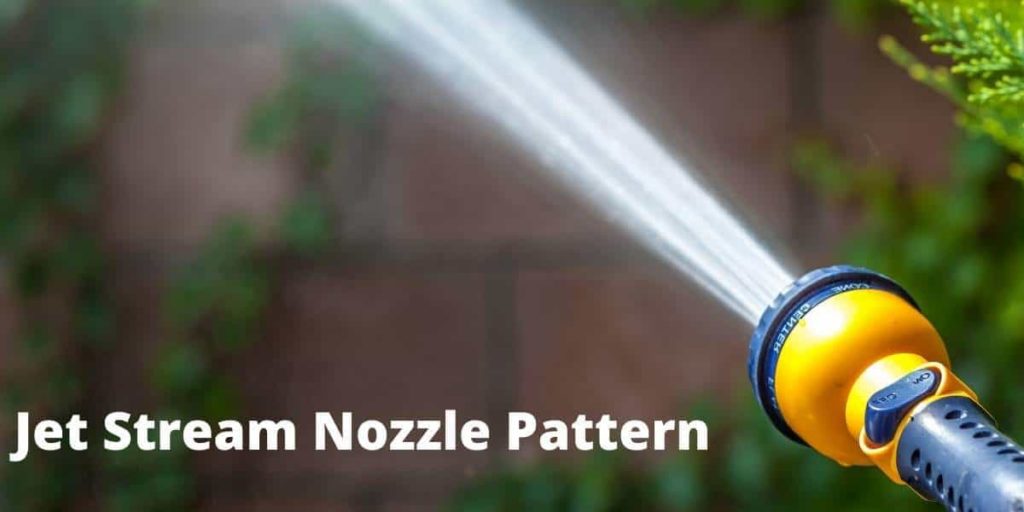
Use The Hose Jet Nozzle for:
- watering distant spaces in the garden
- watering remote plants where you can’t usually drag your hose pipe to
- used for cleaning activities, as a pressure nozzle for garden hose
- it is the best hose nozzle for washing your car. But it is also used for patio cleaning or other similar outdoor cleaning activities. So, use this nozzle stream pattern in all the situations where you would also use a pressure washer.
The jet spray can have different settings depending on its position on the nozzle head. Depending on the hose nozzle model, the available positions of the jet stream are:
- in the center
- in an angle aiming upwards or downwards
directed to the right or left side
The angled jet stream settings are used for rinsing narrow spaces. You can use them for rinsing cars, cleaning outdoor gardening tools, etc.
There are nozzles that can include all the jet spray options and other nozzle sprayers that include only some of the jet stream options. But in all cases, the jet nozzle serves the same scope of directing the water with high precision.
Shower Stream
The garden hose shower head produces a milder but compact stream. Around 80% of the nozzle head will be active, spraying water when using this stream pattern.
It produces a shower-like spray, similar to the rain shower pattern. The water stream pressure is moderate to high.
This type of nozzle stream delivers a high volume of water which gets distributed evenly.
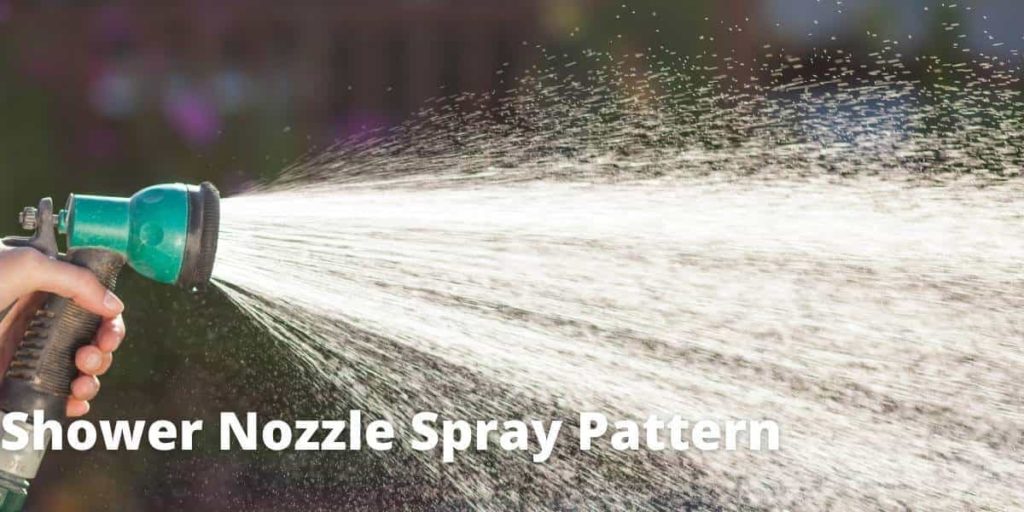
Use the Hose Shower Nozzle Sprayer for:
- watering plants and garden beds. Best used for plants that need a gentle, rain-like watering pattern
- filling in watering cans, or water tanks and water buckets. In case you need to do such activities, this is the best nozzle pattern to use, as the stream is not so powerful.
- washing your pets outdoors, during the summer season. This is the best hose nozzle for dogs, due to the mild pressure and high volume of water that it can deliver.
Mist Stream or Fog Stream
The fine mist hose attachment produces a shower spray but with very small droplets. This type of nozzle pattern is also called fog nozzle stream. The water gets distributed equally and the mist spray hose nozzle covers a larger area when used.
The garden misting nozzles distribute a low-pressure water stream.
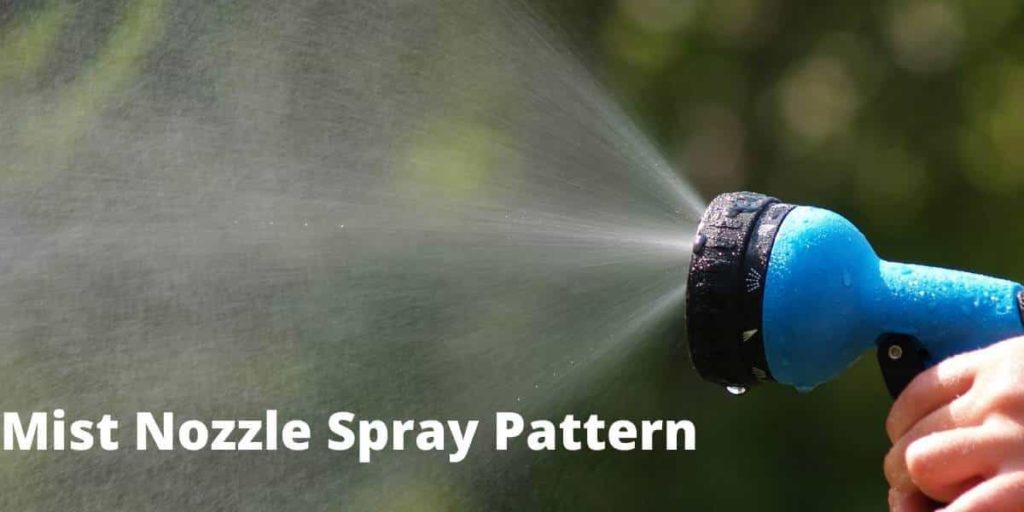
Use the water spray mist nozzle for garden:
- to water young, fragile plants
- to freshen up the plants that love wet foliage. In this case, use it either early in the morning or later in the evening. Do not use it during the day, when the sunlight is strong as it is not healthy for your plants.
Soaker Stream – Flood Spray
The Soaker nozzle for the water hose produces a very low-pressure water stream. When using a soaker setting on the hose nozzle the hose will distribute a high volume of water. And due to the low-pressure flow, it will seem like the garden soaker nozzle soaks water instead of spraying it.
Use a soaker fan spray nozzle for:
- Watering plant pots or garden beds
- Watering at a small distance from the soil level.
- Watering close to the plant roots
- Gentle watering for plants that need a high volume of water at a time.
Flat Stream
The Flat Sprayer Nozzle produces a horizontal water spray line. The water stream has moderate power as the distributed water pressure is medium. This pattern of the hose nozzle allows you to properly control the water flow direction. The water stream has a lower impact than the jet pattern, but the water will still reach far away distances.

Use a flat Stream nozzle for:
- Long-distance watering or watering remote plants
- Different cleaning activities
Cone Stream
The Cone Sprayer Nozzle produces either a hollow or a solid ring of spray. This depends on the type of cone settings available on the nozzle head.
This pattern produces a gentle water stream with low to medium pressure. When using the Cone nozzle pattern, a round area is covered.
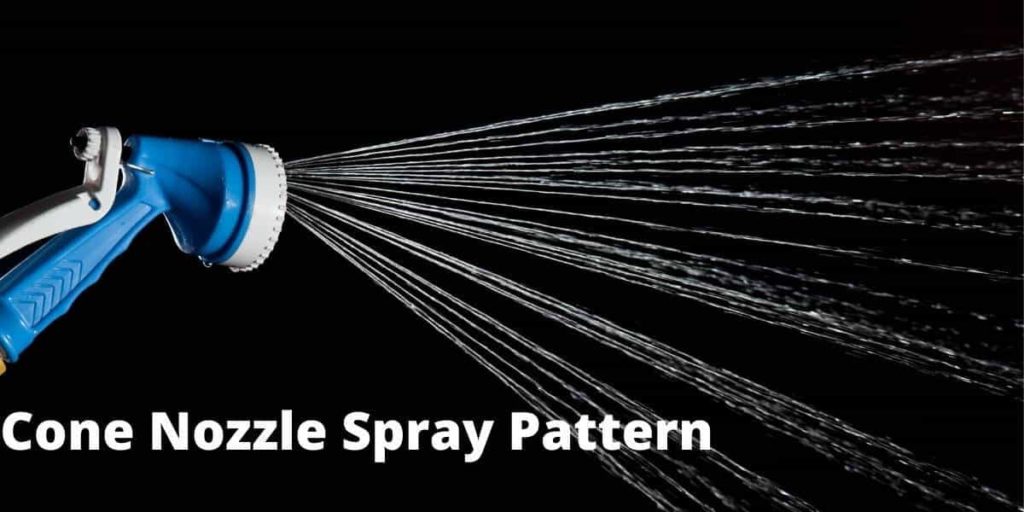
There can be different cone varieties of spraying water. The most frequent ones are:
- The hollow cone produces a circular stream pattern with smaller drop sizes. Thus, the water stream does not have a perfect contour, looking more like a round but solid mist spray.
- The Full Cone or Solid Cone produces a conical stream pattern. It uses higher pressure than the hollow cone. The drop sizes are medium to large.
- The Angled Cone produces an angled conical stream pattern. The angle can be set downwards or upwards. It has the same characteristics as the full cone, the difference is the direction of the water flow.
Use a Cone Stream Nozzle Sprayer for:
- Watering adult plants
- Cleaning activities that need moderate water pressure.
Conclusion
Using one or more types of hose nozzles with your standard gardening hose will definitely improve the watering activities in your garden. But before actually purchasing a water nozzle it is best to understand more about these water hose accessories.
The information that we shared in this post will help you understand what water hose nozzles are, how do they work and how to use them.
Additionally, we detailed each nozzle spraying pattern so you can better understand which ones to look for when choosing your nozzle sprayer.
Read more about nozzles in the post section below or in the dedicated category on our blog.
